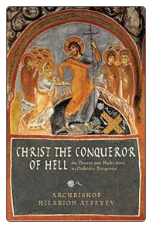|
|
|
|
|
|
|
|
|
|
|
|
|
|
|
|
|
|

Book: Christ the Conqueror of Hell
 |
| Click to enlarge image(s) |
The Descent into Hades from an Orthodox Perspective
This in-depth study on the realm of death presents a message of hope held by the first generation of Christians and the early church. Using Scripture, patristic tradition, early Christian poetry, and liturgical texts, Archbishop Hilarion explores the mysterious and enigmatic event of Christ's descent into Hades and its consequences for the human race. Insisting that Christ entered Sheol as Conqueror and not as victim, the author depicts the Lord's descent as an event of cosmic significance opening the path to universal salvation. He also reveals Hades as a place of divine presence, a place where the spiritual fate of a person may still change. Reminding readers that self-will remains the only hindrance to life in Christ, he presents the gospel message anew, even in the shadow of death.
Contents
Introduction
Abbreviations
Part One
The Descent into Hades in Scripture and Patristic Tradition
1. The New Testament, Apocryphal Literature,and Early Christian Poetry
Key New Testament Texts
Apocryphal Literature
Early Christian Poetry
2. The Patristic Tradition
Eastern Fathers of the Second and Third Centuries
Eastern Fathers of the Fourth Century
Eastern Fathers of the Fifth to Eighth Centuries
Western Church Writers
Part Two
The Descent into Hades in Liturgical Texts
3. Eastern Christian Liturgical Poetry of the Fourth through Sixth Centuries: From Ephrem the Syrian to Romanos the Melodist
The Hymns of St Ephrem the Syrian
The Kontakia of St Romanos the Melodist
4. Liturgical Texts of the Orthodox Church
The Octoechos
The Lenten Triodion
The Pentecostarion
Epilogue
The Theological Significance of Christ's Descent into Hades
Some Conclusions
General Church Doctrine and Personal Opinion
The Descent into Hades and Theodicy
The Soteriological Implications of the
Doctrine of the Descent into Hades
Selected Bibliography
Excerpt
Developing this theme, Romanos goes on to say that in order to find "the creation which has gone astray" the Son of God came down to earth, became incarnate, ascended to the cross, "as a lamp in a lampstand, and from there saw ancient Adam, sitting in darkness and gloom." After his death Christ descends into Hades. His divinity remains united with his humanity; his light illumines and fills up the nether world. Hades tries to keep the body of Christ in its hold but Christ, "as though arising from sleep, enchains Hades violently and puts him down." Addressing himself to those in Hades, Christ says:
'Rise up, all, and trample down Hades! Adam, come to me with Eve now. Do not be afraid, liable for past debts, I have paid them all, I, the Life and Resurrection.'





